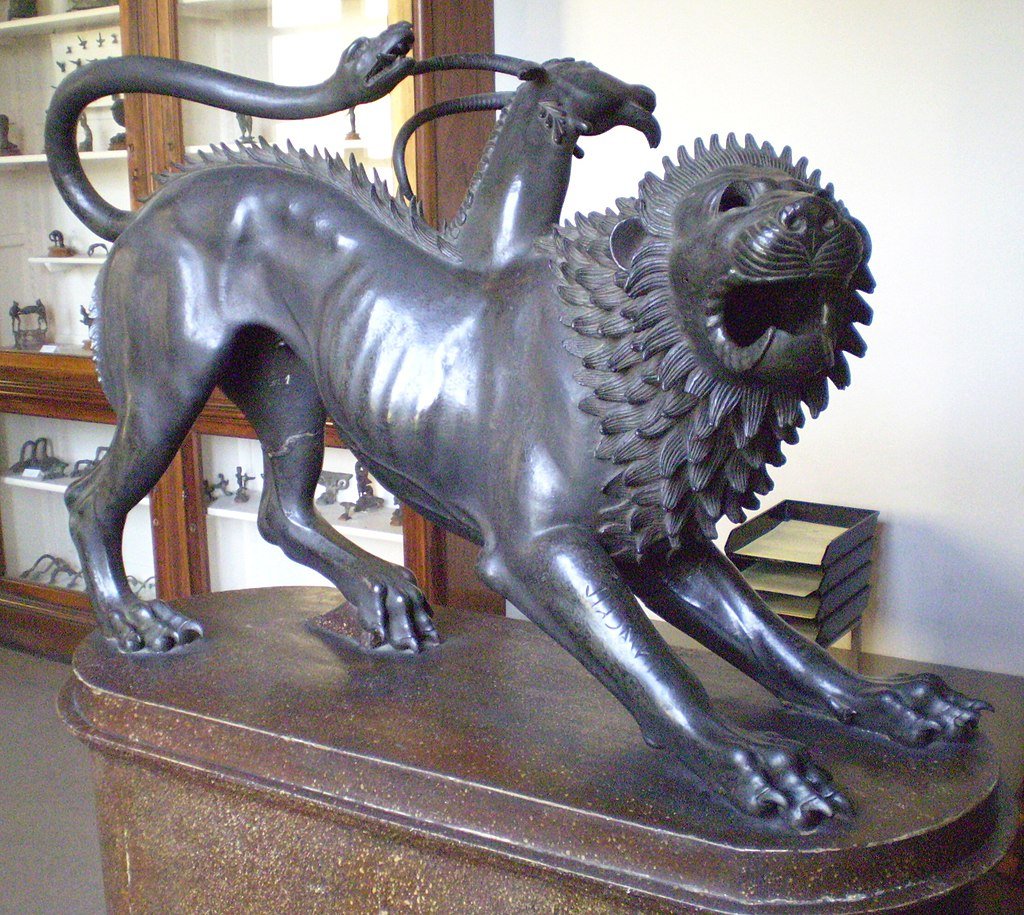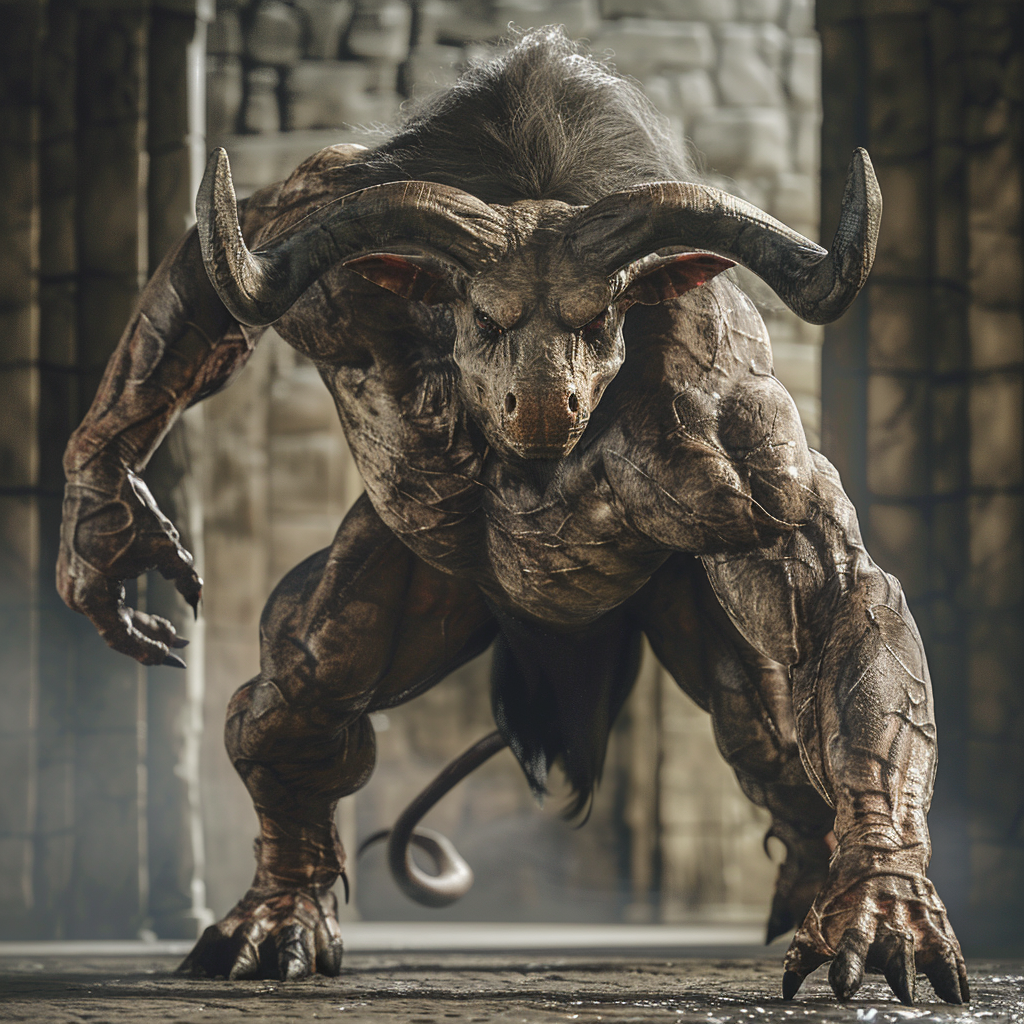Introduction
Embark on an odyssey into the chilling depths of Greek mythology, where every shadow conceals a tale of terror. Within this ancient pantheon of gods and monsters, the creatures that dwell are as enigmatic as they are horrifying. From the venomous gaze of Medusa to the ravenous appetite of the Minotaur, these mythical beings have stirred fear in the hearts of mortals for generations. Join us as we unravel the dark and haunting legends that shroud these creatures, peering into the abyss of ancient lore to uncover the secrets of their existence. Step boldly into the realm of myth and legend and prepare to be captivated by the eerie allure of Greek mythology’s most terrifying denizens.
Table of Contents
Typhon

Typhon stands as one of the most fearsome and powerful beings ever to challenge the authority of the gods. Born from the primordial goddess Gaia, Typhon possessed a monstrous form, towering over the tallest mountains with his immense size and strength. His body was said to be covered in a multitude of serpents, his eyes emitting flames, and his voice thundering like the roar of a thousand storms. Typhon’s very presence struck terror into the hearts of both mortals and immortals alike, for he was the personification of chaos and destruction.
Typhon’s reign of terror began when he launched a catastrophic assault on Mount Olympus, the sacred home of the gods, seeking to overthrow Zeus and claim dominion over the cosmos. With his overwhelming power and ferocity, Typhon waged a titanic battle against the Olympian gods, unleashing hurricanes, earthquakes, and volcanic eruptions in his wake. Even Zeus, the king of the gods, trembled before Typhon’s might, forced to confront the monstrous titan in a climactic showdown for the fate of the universe.
Despite his formidable strength, Typhon was ultimately defeated by Zeus, who unleashed his thunderbolts with devastating fury, casting the titan into the depths of Tartarus, the deepest abyss of the Underworld. There, Typhon lay imprisoned beneath the weight of Mount Etna, his fiery breath still causing the earth to tremble and the seas to boil. Though vanquished, the memory of Typhon’s rampage endured as a cautionary tale of the consequences of unchecked chaos and the eternal struggle between order and disorder in the cosmos.
Echidna

Echidna is a creature of both fascination and terror, known as the “Mother of All Monsters.” Born from the primordial gods Chaos and Gaia, Echidna possessed a monstrous form, combining features of various animals in a grotesque hybrid. Her upper body resembled that of a beautiful woman, while her lower half transformed into that of a serpent or dragon, depending on different accounts. Despite her fearsome appearance, Echidna found a mate in Typhon, a monstrous giant, and together they spawned some of the most infamous monsters in Greek mythology.
Echidna’s offspring were a menagerie of terror, including the likes of the Hydra, the Chimera, the Sphinx, and the Nemean Lion, among others. Each creature embodied different aspects of horror and power, wreaking havoc on the mortal world and challenging the mightiest of heroes. Echidna’s role as the progenitor of such monstrous beings solidified her reputation as a figure of dread and fascination in Greek mythology, her name synonymous with the primal forces of chaos and destruction.
Despite her monstrous progeny, Echidna herself remained a figure of mystery, with few myths directly detailing her actions or motivations. However, her presence loomed large in the pantheon of Greek mythology, serving as a reminder of the ever-present threat of chaos and the untamed wilderness that lurks beyond the boundaries of civilization. Echidna’s story, like that of many ancient myths, continues to intrigue and captivate audiences, offering a glimpse into the primal fears and awe-inspiring wonders of the ancient world.
Medusa

Medusa, one of the most iconic and fearsome figures in Greek mythology, was once a beautiful mortal woman. However, her fate took a dark turn when she caught the eye of Poseidon, the god of the sea, in Athena’s temple. Enraged by this defilement of her sanctuary, Athena transformed Medusa’s luscious hair into writhing snakes and cursed her with a gaze that turned anyone who beheld it into stone.
Banished from society and transformed into a monstrous Gorgon, Medusa took up residence on the desolate island of Sarpedon. Her lair became a place of dread, with travelers avoiding it at all costs. Her terrifying appearance and deadly abilities made her a symbol of horror throughout the ancient world, her very name striking fear into the hearts of mortals.
Medusa’s story took a tragic turn when Perseus, guided by Athena and aided by Hermes, sought her head as a prize to save his mother from marriage to an evil king. Using a reflective shield to avoid her gaze, Perseus succeeded in decapitating Medusa while she slept. Even in death, her head retained its petrifying power, becoming a weapon against his enemies and a symbol of triumph over monstrous adversity.
Cerberus

Cerberus, the hound of Hades, stands as a fearsome guardian at the gates of the Underworld in Greek mythology. With three heads, each crowned with a mane of writhing serpents, and a serpent for a tail, Cerberus strikes terror into the hearts of mortals who dare to approach the realm of the dead. Born of Echidna, the mother of monsters, and Typhon, the most fearsome creature in Greek mythology, Cerberus embodies the essence of primal terror and chaos.
The role of Cerberus is crucial in Greek mythology as he serves as the gatekeeper of the Underworld, preventing the living from entering and the dead from escaping. Only the bravest and most cunning heroes have dared to confront Cerberus, often as part of their quests to retrieve lost souls or obtain divine artifacts. One such hero was Heracles (Hercules), who was tasked with capturing Cerberus as one of his twelve labors. Using his immense strength and wits, Heracles succeeded in subduing the ferocious beast and bringing him to the surface, proving his prowess as a hero of unparalleled valor.
Despite his terrifying appearance and ferocious nature, Cerberus also symbolizes the inevitability of death and the boundaries between the realms of the living and the dead in Greek mythology. His presence at the gates of the Underworld serves as a constant reminder of the transient nature of mortal existence and the mysteries that lie beyond the threshold of life and death.
Chimera

The Chimera is a creature of unparalleled terror, born from the fiery depths of divine vengeance. It is said to be the offspring of Typhon and Echidna, two monstrous beings themselves. The Chimera’s appearance is as grotesque as its origins, boasting a lion’s body with the head of a goat protruding from its back and a serpent for a tail. Flames flicker from its mouth, igniting fear in the hearts of all who behold it.
This fearsome beast made its lair in the ancient kingdom of Lycia, where it unleashed havoc upon the land, devouring livestock and terrorizing villagers with its fiery breath. The people of Lycia lived in constant fear of the Chimera’s wrath, unable to quell its insatiable hunger and unmatched ferocity. Its presence cast a shadow of despair over the kingdom, with hope seeming dim against the backdrop of its monstrous reign.
The legend of the Chimera would come to a dramatic climax with the arrival of Bellerophon, a daring hero mounted atop the winged horse Pegasus. Armed with divine weapons and guided by Athena, Bellerophon embarked on a quest to rid the world of the Chimera’s tyranny. Through cunning strategy and sheer bravery, Bellerophon engaged the Chimera in a fierce battle, ultimately defeating the beast by impaling it with a spear. With the Chimera vanquished, peace returned to the kingdom of Lycia, and Bellerophon’s name echoed through the ages as a champion who dared to challenge the darkest of nightmares.
Hydra

In the vast tapestry of Greek mythology, the Hydra emerges as a creature of unparalleled terror and mythic significance. Born of the primordial beings Typhon and Echidna, this multi-headed serpent inhabited the murky swamps of Lerna, its lair veiled in shadows and ancient dread. What made the Hydra truly fearsome was its ability to regenerate heads – for every one severed, two more would sprout in its place, rendering conventional defeat seemingly impossible.
The Hydra’s reign of terror struck fear into the hearts of mortals and posed a formidable challenge to even the most valiant of heroes. Among those who dared to confront this monstrous abomination was the legendary hero Heracles, tasked with completing the Twelve Labors as penance for his sins. Guided by divine strength and the wisdom of Athena, Heracles embarked on a perilous quest to confront the Hydra and rid the world of its menace.
In a titanic clash of strength and cunning, Heracles faced the Hydra in its fetid lair, armed with little more than his wits and the divine blessings of the gods. With each swing of his mighty club, Heracles severed the Hydra’s heads, only to watch in dismay as new ones sprouted in their place. Yet, through perseverance and ingenuity, Heracles emerged triumphant, employing fire to cauterize the Hydra’s wounds and halt its regenerative powers. Thus, the Hydra met its end, its defeat becoming the stuff of legend and a testament to the indomitable spirit of heroism in the face of adversity.
Harpies

The harpies are mythical creatures that embody both terror and divine retribution. These winged beings, often depicted as bird-like creatures with the heads of women, were said to be the personification of storm winds, carrying out the will of the gods with merciless efficiency. Known for their swift and merciless nature, the harpies were feared by mortals and revered by gods alike, their very presence heralding chaos and destruction.
The most infamous harpies in Greek mythology were Aello, Ocypete, and Celaeno, who were tasked with punishing wrongdoers and enforcing divine justice. One of their most notorious deeds was tormenting the blind seer Phineus, who had been cursed by Zeus for his ability to see the future. The harpies would descend upon Phineus’s table as he tried to eat, snatching away his food and leaving him in a state of perpetual hunger and despair.
Despite their fearsome reputation, the harpies also served as symbols of divine order and justice in Greek mythology. Their relentless pursuit of wrongdoers and their role as agents of divine punishment reinforced the belief that no one could escape the consequences of their actions, even in the face of seemingly insurmountable odds. Thus, the harpies represented not only the darker aspects of the human condition but also the eternal struggle between order and chaos in the cosmos.
Minotaur

In the labyrinthine depths of Greek mythology lies the story of the Minotaur, a creature of terror and tragedy. Born of the union between Pasiphaë, Queen of Crete, and a divine bull sent by Poseidon, the Minotaur possessed the body of a man and the head of a bull. King Minos, Pasiphaë’s husband, was horrified by the monstrous offspring and commissioned the famed craftsman Daedalus to construct a labyrinth beneath the palace of Knossos to contain it.
The Minotaur’s existence became a dark chapter in the history of Crete, as he was fed a diet of human sacrifices, sent as tribute from Athens as punishment for the death of Minos’s son. Theseus, the Athenian hero, volunteered to be one of the sacrificial victims and embarked on a mission to slay the Minotaur. Guided by Ariadne, Minos’s daughter, who gave him a ball of thread to navigate the labyrinth, Theseus successfully confronted the Minotaur and emerged victorious, marking the end of the creature’s reign of terror.
The tale of the Minotaur serves as a cautionary reminder of the consequences of hubris and the destructive power of unchecked rage. Trapped within the labyrinth, the Minotaur represented the darker impulses of humanity, driven by primal instincts and condemned to a life of violence and isolation. Yet, his defeat at the hands of Theseus symbolized the triumph of courage and virtue over savagery, offering hope in the face of seemingly insurmountable odds.
Scylla and Charybdis


The tale of Scylla and Charybdis unfolds as a harrowing maritime legend that has captivated storytellers for centuries. Scylla, a monstrous sea creature with six heads and twelve legs, dwelled on one side of a narrow strait, while Charybdis, a deadly whirlpool capable of devouring ships whole, churned the waters on the opposite side. These twin perils formed an impassable gauntlet for sailors navigating the treacherous waters between them.
The legend of Scylla and Charybdis is best known from Homer’s epic poem, the “Odyssey,” where the hero Odysseus and his crew encounter the deadly duo during their long voyage home from the Trojan War. Faced with the impossible choice of navigating past Scylla’s lair, where she would snatch six of his men, or risking the entire ship to the engulfing vortex of Charybdis, Odysseus opts for the lesser of two evils, sacrificing some of his crew to the ravenous jaws of Scylla in order to save the rest from the watery abyss.
This myth serves as a timeless allegory for the perils of decision-making and the harsh realities of life’s trials. It embodies the ancient Greek understanding of the world’s unpredictability and the necessity of making difficult choices in the face of adversity. Through the exploits of Odysseus and the terror of Scylla and Charybdis, the legend transcends its mythological roots to offer enduring lessons about courage, sacrifice, and the enduring struggle against the forces of nature.
Conclusion
Embarking on an odyssey into the chilling depths of Greek mythology’s most terrifying denizens is a journey that unveils not just tales of horror, but also timeless lessons about the human condition. From the monstrous offspring of Echidna and Typhon to the fearsome guardians of the underworld like Cerberus, these creatures embody the primal fears and awe-inspiring wonders of the ancient world. Through their stories, we glimpse into the abyss of ancient lore and confront the darker aspects of existence, from the consequences of unchecked chaos to the inevitability of death itself.
Yet, amidst the shadows of these chilling tales, there is also resilience, courage, and the triumph of the human spirit over adversity. Heroes like Perseus, Heracles, and Theseus face these creatures head-on, displaying bravery and ingenuity in the face of overwhelming odds. Their victories serve as beacons of hope, reminding us that even in the darkest of times, there is always the potential for triumph and redemption.
As we conclude our journey through the chilling depths of Greek mythology, we are left with a newfound appreciation for the enduring power of these ancient tales. They continue to captivate and terrify audiences across the ages, offering insights into the human psyche and the eternal struggle between order and chaos, light and darkness. In the end, the stories of these mythical creatures serve as a reminder of the enduring legacy of Greek mythology and its timeless relevance in understanding the complexities of the human experience.
For more articles you can click here, thanks for reading.





